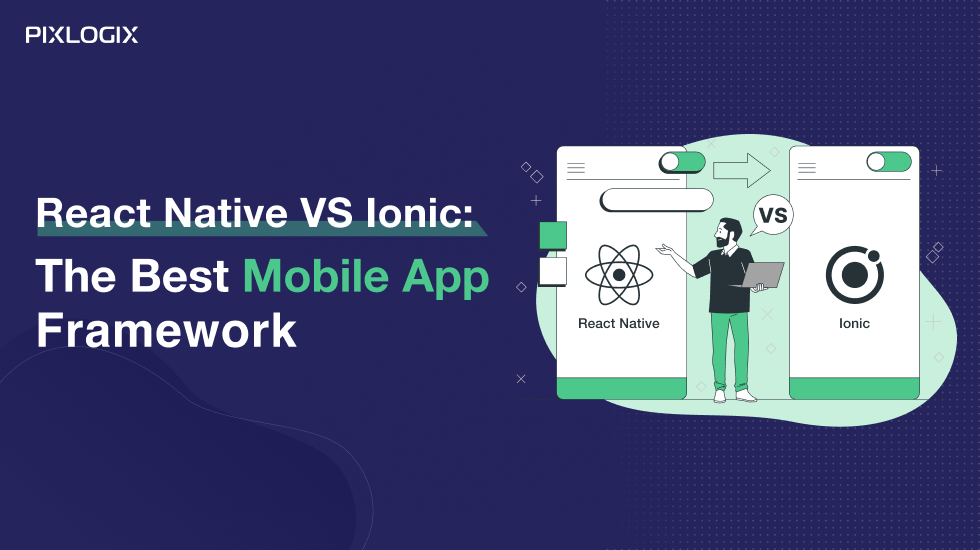React vs Angular: Which is best JS Framework for Front-end Development?

- Last Updated On February 29, 2024
- 13 min read
Unlocking the Power of Front-End Development: React vs Angular
In the ever-evolving landscape of web technologies, front-end development stands at the forefront of innovation. As businesses strive to create robust and scalable web applications, choosing the right JavaScript framework becomes paramount. But fear not, even if you’re not a tech wizard, we’re here to guide you through the maze of options.
In this blog, we embark on a journey to dissect the fundamental differences between React vs Angular. By the end, you’ll be equipped with the knowledge needed to make an informed decision for your next front-end project. So, let’s dive in!
Explore The Key Points on – React vs Angular
| Feature | React | Angular |
|---|---|---|
| Type | JavaScript library | TypeScript-based JavaScript framework |
| Focus | Building user interfaces | Building full-fledged web applications |
| Structure | Component-based | MVC (Model-View-Controller) architecture |
| Data binding | One-way | Two-way |
| DOM manipulation | Virtual DOM | Real DOM |
| Learning curve | Easier, more flexible | Steeper due to framework complexity |
| Performance | Potentially faster due to virtual DOM | Can be slower for large applications |
| Community & libraries | Larger, more diverse | Smaller, tightly integrated with Angular ecosystem |
| Server-side rendering | Requires additional libraries | Built-in feature |
| Mobile development | Needs separate libraries like React Native | Native mobile apps can be built with Angular Mobile Toolkit |
| Commonly used for | Single-page applications, UI components, dynamic websites | Complex enterprise applications, large single-page applications, progressive web apps |
Understanding React

React is a popular JavaScript library for building web application user interfaces (UIs). This JavaScript framework is developed by Facebook. This JS framework focuses on creating reusable UI components that efficiently update and render based on changes in data. It utilizes a virtual DOM (Document Object Model) and a component-based architecture for optimized rendering.
Features of React:-
- React utilizes JSX to write HTML-like code within JavaScript.
- With the in-built state management, Each component can have its own state, which represents mutable data specific to that component.
- React utilizes a virtual DOM.
- React follows a component-based architecture, dividing UIs into modular and reusable components.
- React enforces a unidirectional data flow, where data flows in a single direction from parent components to child components.
- By maintaining a clear flow of data, React helps reduce bugs, enhances code predictability, and simplifies the debugging process.
- React hooks eliminate the need for class components, enabling developers to write cleaner and more concise code.
Understanding Angular

Angular is a robust and widely adopted JavaScript framework for building modern web applications. Developed by Google, Angular provides developers with a comprehensive toolkit and a structured approach to front-end development. It follows the Model-View-Controller (MVC) architectural pattern and emphasizes modularity, reusability, and testability.
Features of Angular:-
- Angular is built with TypeScript.
- This JS framework offers a powerful templating system that allows developers to define the structure and layout of their application’s UI.
- It has a dependency injection (DI) system, simplifying managing dependencies between different components so you can decouple components, improve code maintainability, and facilitate unit testing.
- Angular promotes a component-based architecture, where the application is divided into modular and reusable components.
- It includes a robust routing module that enables developers to build single-page applications (SPAs) with multiple views.
- It provides powerful two-way data binding, allowing seamless synchronization between the data model and the UI.
- Angular strongly emphasizes testing, making it easier for developers to write reliable and maintainable code.
Related Post: 7 Most Powerful Mobile Application Development Framework
#1: Performance

React
React’s performance is renowned for its efficient rendering mechanism and the use of a Virtual DOM(Document Object Model). React’s Virtual DOM allows it to update and render only the necessary components, minimizing unnecessary re-renders and optimizing performance.
By keeping track of changes and efficiently updating the UI, React ensures a smooth user experience. Additionally, React provides performance optimization techniques such as memoization and using keys for efficient list rendering.
Angular
Angular also prioritizes performance by employing various strategies. It utilizes a change detection mechanism that tracks changes in data and updates the UI accordingly. Angular’s change detection operates through zones, enabling efficient change tracking.
Moreover, Angular provides built-in features like lazy loading, which allows for loading components and modules on-demand, enhancing overall performance. Angular’s Ahead-of-Time (AOT) compilation further improves runtime performance by precompiling templates.
Verdict
In terms of performance, both JS frameworks offer you robust features. So, it’s a tie between React and Angular.
Related Post: Swift vs Flutter | Best Mobile App Development Framework
#2: Scalability

React
React offers flexibility and scalability, particularly in managing application state. While React is a view library, developers often use external state management libraries like Redux or MobX to handle complex state management scenarios.
These libraries provide centralized and predictable state management, making it easier to scale React applications. By using a unidirectional data flow and separating concerns through components, React applications can be effectively scaled as they grow in complexity.
Angular
Angular, being a full-featured framework, provides built-in solutions for scalability. It offers a powerful module system that helps organize code and separate concerns. Angular’s dependency injection mechanism facilitates the creation of modular and reusable components, enhancing scalability.
Angular’s reactive forms feature simplifies handling complex form validation and data binding, ensuring efficient management of user input. Additionally, Angular’s router supports lazy loading, enabling the loading of modules on-demand and enhancing scalability.
Verdict
React offers you state management libraries. Similarly, Angular has in-build features for the scalability of your projects. So I give 1 point to Angular for scalability.
#3: Memory Management and Efficiency

React
React’s lightweight nature and efficient rendering contribute to memory management and efficiency. React’s Virtual DOM allows it to minimize unnecessary re-renders, reducing memory consumption and optimizing performance.
React also encourages the use of functional components and hooks, which further improves memory management by reducing the need for class components and reducing the overall code footprint.
Angular
Angular’s memory management and efficiency are achieved through its change detection mechanism and optimized rendering strategies. Angular’s change detection system detects and updates only the components affected by changes, reducing unnecessary updates and memory usage. Also, Angular’s AOT compilation optimizes the size of the code bundle, resulting in efficient memory utilization.
Verdict
For memory management and efficiency, React looks superior compared to Angular.
#4: Learning Curve

React
React is known for its relatively shallow learning curve, making it accessible to developers familiar with JavaScript and web development concepts. React’s simplicity lies in its component-based architecture, which allows developers to build reusable UI components.
The framework follows a straightforward approach to managing state and rendering components, which developers can quickly grasp.
Angular
As compared to React, Angular provides a steeper learning curve. Angular is a comprehensive framework that encompasses various concepts, such as dependency injection, TypeScript, modules, and decorators.
Developers new to Angular may require some time to understand and adapt to its structure and conventions. However, once the learning curve is overcome, Angular provides a powerful development environment with robust features and tools.
Verdict
React has by far the easier learning curve as compared to the AngularJS framework.
Related Post: BEST GUIDE TO HIRE LARAVEL DEVELOPMENT COMPANY
#5: Developer Experience and Productivity

React
React’s emphasis on simplicity and modularity contributes to a smooth developer experience. React’s component reusability enables developers to create modular and maintainable codebases.
Too React’s vast ecosystem offers a wide range of third-party libraries and tools, allowing developers to leverage existing solutions and enhance productivity. React also provides a lightweight development experience, allowing developers to choose their preferred libraries and tools.
Angular
Angular provides a comprehensive and opinionated framework that focuses on providing a complete development experience. It includes an extensive set of tools, such as Angular CLI, which simplifies project setup, scaffolding, and build processes.
Angular’s strong emphasis on TypeScript ensures type safety, improving code maintainability and reducing errors. The framework also offers powerful features like two-way data binding and declarative templates, which streamline development and enhance productivity.
Verdict
It is a tie match between React and Angular. Because there are so many experienced developers in the market who offer you amazing solutions by using both JS frameworks, you can get your desirable result by hiring the right Developer for your project.
#6: Developer Community Support

React
React enjoys a large and active developer community with numerous online resources, tutorials, and forums. The vast community support ensures that developers can find solutions to common issues and seek guidance when facing challenges. React’s popularity also results in frequent updates and improvements, with the community actively contributing to the framework’s growth.
Angular
Angular has strong community support backed by Google. The Angular community offers many resources, including official documentation, tutorials, and active forums. Google’s involvement ensures long-term support and continuous improvement of the framework. Angular follows a regular release cycle, providing developers with predictable updates and ensuring compatibility with previous versions.
Verdict
React has a larger community as compared to Angular.
Top Examples For React and Angular
Examining real-world examples can provide valuable insights into the capabilities of React and Angular. One of the largest social media platforms, Facebook utilizes React extensively across its various applications, including Facebook, Instagram, and WhatsApp. These applications showcase React’s ability to efficiently handle large-scale and complex user interfaces.
Conversely, Angular powers applications like Google, Microsoft, and Forbes, demonstrating its suitability for enterprise-level projects. To sum up, React and Angular are both compelling JS frameworks. That’s why to select the best JS framework; you need to analyze your requirements and needs.
Related Post: TOP 5 FRONT DEVELOPMENT TOOLS TO ENHANCE USER INTERACTION
Conclusion
In the React vs Angular debate, there is no one-size-fits-all answer. React’s component-based architecture, efficient rendering, and strong community support make it an excellent choice for developers seeking flexibility and speed. On the other hand, Angular’s comprehensive framework, robust testing capabilities, and long-term support cater to developers working on large-scale and enterprise projects.
Ultimately, the decision between React and Angular depends on factors such as project requirements, developer familiarity, and personal preferences. Experimenting and exploring both frameworks is advisable to determine which best suits your front-end development needs.
If you still want to learn more about React and Angular JS framework, contact experienced Web development company. Pixlogix is India’s leading web design and development company that offers dedicated web designers and developers on various technologies. So, for any query, please contact our team now.
Samir Bhimbha
Samir Bhimbha is the Founder & CEO of Pixlogix Infotech Pvt. Ltd. which offers web and app solutions to fulfill business's online needs and help to improve their online presence with many clients in the USA, Europe, Australia, and more. He is a skilled entrepreneur, web designer, developer, and team leader who can handle every situation. With 15+ years of experience in UX/UI design and web development, he is leading a team of IT professional talents.
Related Post
Get in Touch Now!
Have a word with our expert consultants about your next project to get suggestive guidance & proposal.





